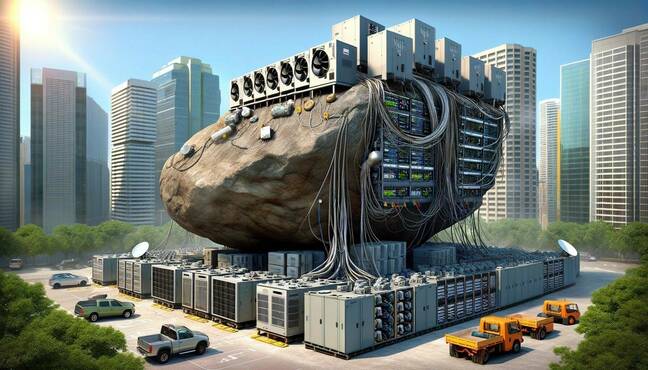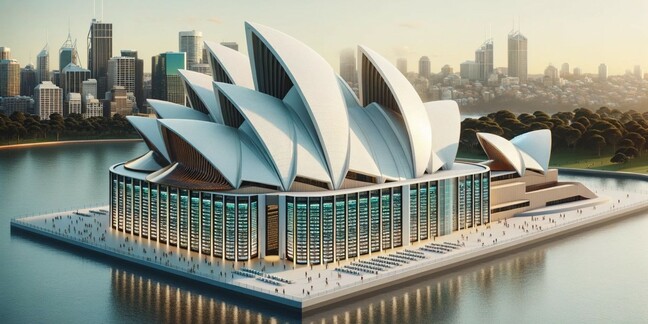Datacenter Architect Creates Bonkers Designs To Illustrate The Craft, And Quirks, Of Building Bit Barns
Charles Fortin can't get excited by 30-storey skyscrapers.
The Sydney-based architect studied at the Illinois Institute of Technology, which specializes in tall buildings, and learned that designing skyscrapers is all about determining how to get services – power and water, mostly – to the people who need them.
"Forty storeys is a midrise in Chicago," he told The Register. But in Sydney, not many buildings top 30 storeys, never mind 40.
Datacenters, however, are more interesting, and Sydney-based clients want plenty of them to build across Australia and the world.
Fortin is therefore busy designing both concepts for datacenters and actual facilities. Clients often come to the firm he serves as managing director, Collard Maxwell Architects (CM+A), after first hiring generalist architects who lack the experience to realize a client's vision, or don't understand the nuances of datacenter design.
CM+A has designed datacenters since long before they were plentiful, or popular. Its founders worked on projects that housed punch-card machines.
- Backblaze starts tracking hot drives as world preps for rising global temperatures
- Fujitsu-backed FDK claims nickel zinc batteries ready for use in UPSes
- Datacenter would spoil beautiful view ... of former industrial waste dump
- China details relocation plan for up to five million datacenter racks
Then as now, the principles of datacenter design start with consideration of power and cooling services. Surveillance and security services are also vital but require less space.
Planning those services means calling on the same skills needed to build a skyscraper.
"Just like a high-rise you design the core as tight as you can," he told The Register. "Make it as tight as possible on the inside and branch a building around that."
Hyperscalers like Equinix, he noted, want designs for large buildings that they can operate without needing to fill them with racks and equipment. Crypto-centric clients, on the other hand, insist on liquid cooling and often insist on difficult designs that Fortin sometimes finds impractical, but which after more work have turned out to be clever.
Whatever the brief, Fortin explained that 20 percent of a datacenter's area is usually shared between the operator's offices, facilities for tenants, and storage areas. Forty percent is data halls, and the remaining 40 percent is occupied by the kit needed to keep the bit barn powered, connected, and cooled.
Fortin likes to doodle datacenter designs for different occasions, and recently posted a few to LinkedIn where The Register spotted them. With his permission, we present some of his designs, starting with the one below. It's a datacenter destined to blend in with the Australian outback – a location where the abundance of solar energy saw Fortin imagine a cold storage facility. He also thinks the outback's remoteness makes it a secure location for storing seldom-accessed data.
Another design was inspired by datacenter operators contemplating their own small modular nuclear reactors as a power source. Such reactors, Fortin noted, need a lot of water to keep them cool. And as nuclear reactors, rightly or wrongly, remain somewhat unpopular, he imagined an atom-powered datacenter cruising the seven seas and using satellite connectivity to serve data.
Another of his offerings plays with datacenters' need for reliability and redundancy, and their role at the core of business, by building one into and around a heart-shaped rock – or is it brain-shaped?
Datacenters on wheels are another idea Fortin wanted to explore, as are personal datacenters. And if that means mounting them in a car to get cheap cooling, why not?
Fortin also decided his hometown's most famous building – the Sydney Opera House – could become a datacenter.
On a more serious note, Fortin cautioned those considering a datacenter to remember the basics: like whether enough power is available to match a design. He's had clients brief him without checking that first. He also counsels considering – but not always following – the Uptime Institute's four-tiered resilience ratings.
"Those specs make sense for some business cases," he advised. "But you may not need to have all their requirements." Having fun is another option – one reason Fortin shared his designs is as a reminder that datacenters don't have to be featureless boxes. ®
From Chip War To Cloud War: The Next Frontier In Global Tech Competition
The global chip war, characterized by intense competition among nations and corporations for supremacy in semiconductor ... Read more
The High Stakes Of Tech Regulation: Security Risks And Market Dynamics
The influence of tech giants in the global economy continues to grow, raising crucial questions about how to balance sec... Read more
The Tyranny Of Instagram Interiors: Why It's Time To Break Free From Algorithm-Driven Aesthetics
Instagram has become a dominant force in shaping interior design trends, offering a seemingly endless stream of inspirat... Read more
The Data Crunch In AI: Strategies For Sustainability
Exploring solutions to the imminent exhaustion of internet data for AI training.As the artificial intelligence (AI) indu... Read more
Google Abandons Four-Year Effort To Remove Cookies From Chrome Browser
After four years of dedicated effort, Google has decided to abandon its plan to remove third-party cookies from its Chro... Read more
LinkedIn Embraces AI And Gamification To Drive User Engagement And Revenue
In an effort to tackle slowing revenue growth and enhance user engagement, LinkedIn is turning to artificial intelligenc... Read more






